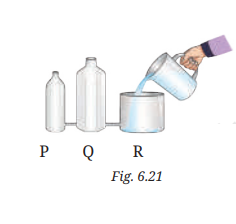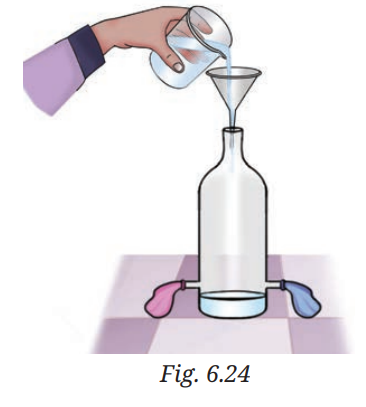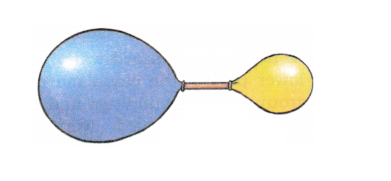Solutions For All Chapters – Science Class 8
Pressure, Winds, Storms, and Cyclones
Keep the curiosity alive
1. Choose the correct statement.
(i) Look at Fig. 6.21 carefully. Vessel R is filled with water. When pouring of water is stopped, the level of water will be ____________________.
(a) the highest in vessel P
(b) the highest in vessel Q
(c) the highest in vessel R
(d) equal in all three vessels
Answer:- (d) equal in all three vessels
(ii) A rubber sucker (M) is pressed on a flat smooth surface and an identical sucker (N) is pressed on a rough surface:
(a) Both M and N will stick to their surfaces.
(b) Both M and N will not stick to their surfaces.
(c) M will stick but N will not stick.
(d) M will not stick but N will stick.
Answer:- (c) M will stick but N will not stick.
(iii) A water tank is placed on the roof of a building at a height ‘H’. To get water with more pressure on the ground floor, one has to
(a) increase the height ‘H’ at which the tank is placed.
(b) decrease the height ‘H’ at which the tank is placed.
(c) replace the tank with another tank of the same height that can hold more water.
(d) replace the tank with another tank of the same height that can hold less water.
Answer:- (a) increase the height ‘H’ at which the tank is placed.
(iv) Two vessels, A and B contain water up to the same level as shown in Fig. 6.22. PA and PB is the pressure at the bottom of the vessels. FA and FB is the force exerted by the water at the bottom of the vessels A and B.
(a)PA=PB,FA= FB
(b)PA=PB,FA<FB
(c)PA<PB,FA=FB
(d)PA > PB , FA > FB
Answer:- (b)PA=PB,FA<FB
2. State whether the following statements are True [T] or False [F]
(i) Air flows from a region of higher pressure to a region of lower pressure.
Answer: True (T)
(ii) Liquids exert pressure only at the bottom of a container.
Answer: False (F)
(iii) Weather is stormy at the eye of a cyclone.
Answer: False (F)
(iv) During a thunderstorm, it is safer to be in a car.
Answer: True (T)
3. Fig. 6.23 a shows a boy lying horizontally, and Fig. 6.23b shows the boy standing vertically on a loose sand bed. In which case does the boy sink more in sand? Give reasons
Answer:- The boy sinks more when standing vertically on loose sand as shown in Fig. 6.23(b).
Reason: When the boy stands, the entire weight acts on a smaller area (his feet), creating more pressure on the sand.
Pressure = Force / Area Since area is less while standing, pressure is more. This increased pressure causes the boy to sink more.
In Fig. 6.23(a), the boy is lying down, so the same weight is spread over a larger area, resulting in less pressure, and hence, less sinking.
4. An elephant stands on four feet. If the area covered by one foot is 0.25 m², calculate the pressure exerted by the elephant on the ground if its weight is 20000 N.
Answer:
Given:
- Weight of the elephant = 20000 N
- Area of one foot = 0.25 m²
- Total area of 4 feet = 4 × 0.25 = 1.0 m²
Formula:Pressure = Force / Area
Calculation:Pressure = 20000 N / 1.0 m² = 20000 N/m² or 20000 Pascal (Pa)
Reason:Pressure is the force applied per unit area. Since the elephant’s weight is distributed over 4 feet, the total area increases, reducing the pressure on the ground.
5. There are two boats, A and B. Boat A has a base area of 7 m² ,and 5 persons are seated in it. Boat B has a base area of 3.5 m², and 3 persons are seating in it. If each person has a weight of 700 N, find out which boat will experience more pressure on its base and by how much?
Answer:- Given:
Weight of each person = 700 N
Boat A:
- Base area = 7 m²
- Number of persons = 5
- Total weight = 5 × 700 = 3500 N
Boat B:
- Base area = 3.5 m²
- Number of persons = 3
- Total weight = 3 × 700 = 2100 N
Pressure = Force / Area
- Pressure on Boat A:= 3500 N / 7 m² = 500 N/m²
- Pressure on Boat B:= 2100 N / 3.5 m² = 600 N/m²
Conclusion:Boat B experiences more pressure on its base.
Difference in pressure:600 N/m² – 500 N/m² = 100 N/m²
So, Boat B experiences 100 N/m² more pressure than Boat A.
6. Would lightning occur if air and clouds were good conductors of electricity? Give reasons for your answer.
Answer:- No, lightning would not occur if air and clouds were good conductors of electricity.
Reason:Lightning happens because air is a poor conductor of electricity, which allows opposite electric charges to build up in clouds and between clouds and the ground. When the charge becomes too large, the air’s resistance breaks down, and a sudden discharge occurs in the form of lightning.
If air and clouds were good conductors, charges would flow easily without building up. Therefore, no sudden discharge would take place, and lightning would not occur.
7. What will happen to the two identical balloons A and B as shown in Fig. 6.24 when water is filled into the bottle up to a certain height. Will both the balloons bulge? If yes, will they bulge equally? Explain your answer.
Answer:- Yes, both the balloons A and B will bulge, but they will bulge equally.
Reason:When water is poured into the bottle, it creates a water column. The pressure at the bottom of the bottle due to the water column acts equally in all directions, including the two side openings where the balloons are attached.
Even if the bottle shape or the side holes are different, the pressure at the same depth (height of water) remains equal, so both balloons bulge the same amount.
This shows that liquids exert equal pressure at the same height in all directions.
8. Explain how a storm becomes a cyclone.
Answer:-
1. Heating of ocean water – Warm ocean water heats the air above it.
2.Rising moist air – Warm, moist air becomes lighter and rises, creating a low-pressure area.
3. Condensation – As the moist air rises higher, it cools, and the water vapour condenses into raindrops. This releases heat into the atmosphere.
4. Further warming – The released heat warms the surrounding air, making it rise even more strongly.
5. Continuous cycle – More air from surrounding areas rushes in to fill the low pressure. This air also rises, and the cycle repeats.
6. Spinning effect – The Earth’s rotation (Coriolis effect) makes the moving air spin around the low-pressure centre.
7. Cyclone formation – A very low-pressure system with high-speed rotating winds and heavy rain develops, which is called a cyclone.
9. Fig. 6.25 shows trees along the sea coast in a summer afternoon. Identify which side is land- A or B. Explain your answer.
Answer:
During the daytime on a summer afternoon, there is a sea breeze that blows from sea to land. This happens because the land gets heated faster and the air above land rises resulting in low-pressure region over land. Cooler air over sea moves from high- pressure region towards the land. The bending of trees due to wind, as shown in the figure, suggests that wind is blowing in the direction from B to A. This suggests ‘A’ side is land.
10. Describe an activity to show that air flows from a region of high pressure to a region of low pressure.
Answer:-
Activity to show that air flows from a region of high pressure to a region of low pressure:
Take two balloons and a drinking straw.
- Insert one end of the straw into an uninflated balloon and tie it tightly.
- Inflate the second balloon and hold its mouth closed.
- Insert the other end of the straw into the neck of the inflated balloon and seal it tightly.
- Now, let go of the mouth of the inflated balloon.
Observation:- Air from the inflated balloon starts moving into the uninflated balloon. The size of the inflated balloon becomes smaller, while the uninflated balloon starts to expand.
Explanation:- Air moves from the high-pressure area (inside the inflated balloon) to the low-pressure area (inside the uninflated balloon). This proves that air always flows from a region of high pressure to a region of low pressure.
11. What is a thunderstorm? Explain the process of its formation.
Answer:- A thunderstorm is a storm that includes thunder, lightning, heavy rain, and strong winds. It usually happens in hot and humid regions.
Process of its formation:
1. During hot and humid days, the air near the ground becomes warm and full of moisture.
2. This warm moist air rises up into the sky.
3. As it rises, the air cools down, and the water vapor in it condenses to form clouds.
4. This process releases heat, which makes the air rise even faster.
5. The clouds formed are called cumulonimbus clouds.
6. Inside these clouds, water droplets and ice particles bump into each other, creating electric charges.
7. When the positive and negative charges meet, lightning is produced.
8. The heat from the lightning makes the air expand rapidly, which causes thunder.
9. The cloud becomes heavy with water and falls as rain, often with strong winds.
So, a thunderstorm forms due to the rapid upward movement of warm, moist air and the formation of large, charged clouds
12. Explain the process that causes lightning.
Answer:- Lightning is caused by the buildup of electric charges in clouds during thunderstorms. When clouds move and rub against each other, they generate charges-positive at the top and negative at the bottom. The ground becomes positively charged. When the difference between the charges becomes very high, the negative charges from the cloud flow to the positive charges on the ground or in other clouds. This sudden movement of charges produces a bright flash of light, which we see as lightning.
13. Explain why holes are made in banners and hoardings.
Answer:- Holes are made in banners and hoardings to allow air to pass through them easily.
Explanation: When strong wind blows, it creates pressure on the surface of banners and hoardings. If there are no holes, the wind pressure may tear or blow them away. But when holes are made, air passes through these holes, which reduces the air pressure acting on the surface. This helps the banner or hoarding to remain stable and prevents it from being damaged by the wind.
So, the holes help to reduce wind pressure and protect the banner or hoarding from tearing.








Leave a Reply